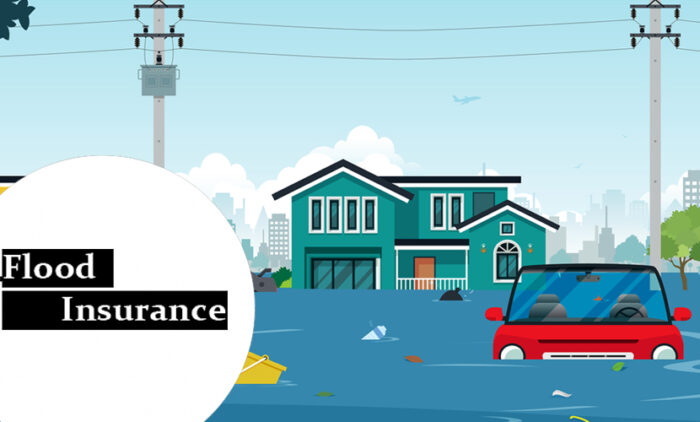Getting a flood insurance policy is a great idea, especially if you reside in an area prone to such accidents. Flood insurance is a property policy designed to protect residences from losses due to floods. This policy is available for all residential and business properties.

The National Flood Insurance Program (NFIP) provides flood insurance to homeowners in every community with policies. However, the cost of the flood insurance policy is determined by several factors. These factors include the NFIP-selected flood zone, property age, elevation, and the number of floors.
So, if you are interested in obtaining flood insurance for your apartment to cover expenses during flood accidents. You can opt for the NFIP or choose other private personal flood insurance companies based on the coverage you want.
How Does Flood Insurance Work?
This insurance type is considered catastrophe insurance, distinct from the hazard coverage typically found in homeowners insurance policies. It is available for both residential and commercial properties.
Standard homeowners insurance covers interior water damage from storms or burst pipes but typically excludes floodwater damage. This is why property owners residing in flood-prone areas are required to obtain special insurance to protect against such risks.
Flood insurance is a product where the insured pays a yearly premium based on the property’s flood risk and chosen deductible.
It safeguards homeowners from asset destruction due to external factors like rain, snow, storms, or dam failures. As they receive compensation for necessary repairs and/or reconstruction of the structure, up to the policy limit.
Unlike homeowners policy, this policy requires policyholders to purchase separate policies to cover both the dwelling and its contents.
Additionally, a separate coverage rider may be necessary to cover sewer backup, particularly when the backup is unrelated to rising floodwaters.
How Much Flood Insurance Cost?
The NFIP manages the cost of flood insurance policies and maintains consistency between issuers. If you reside in a flood zone or participating community of NFIP, they can assist in locating an insurance agent.
However, when determining policy expenses, your agent will consider some factors. These factors include:
- The location and size of your home.
- Your home’s proximity to water bodies.
- Elevation.
- The type of coverage chosen (replacement cost value versus actual cost value).
- Flood zone designation.
- Property age.
- And the number of floors, all of which impact pricing.
The Preferred Risk Policy offers property coverage for both buildings and contents in an average-to-low-risk area for a single price. Communities implementing flood safeguards may qualify for NFIP discounts, resulting in a broad range of annual premiums.
For NFIP policies, the maximum coverage for residential buildings is $250,000 and $100,000 for contents. Businesses can also obtain a maximum of $500,000 for building coverage and $500,000 for content coverage.
However, it’s important to note that you can also explore policy coverage on your own. That is if you wish to cover your property for a significant price. Starting with a policy that issues regular homeowners’ insurance is a good choice.
The National Flood Insurance Program (NFIP)
The National Flood Insurance Program (NFIP) is administered by the Federal Emergency Management Agency (FEMA). It offers flood insurance to homeowners in participating communities and those residing in NFIP-selected flood zones.
Note: Actual insurance policies are not directly provided by the NFIP or FEMA but by private insurers.
FEMA regularly updates flood zone maps across the U.S. in areas that are prone to flooding. These zones are categorized for rating purposes, such as Zones B, C, and X, representing normal to minimal flood risk.
Minimal flood risk indicates a less than 1% chance of flooding annually. High-risk properties are typically found in zones designated as A, which have higher floodwater heights and an overall higher incident rate over a 30-year mortgage. Properties with a V designation are similar to those in Zone A but are located in high-risk coastal areas.
However, some homeowners may be placed in Zone D, indicating an undetermined risk for the area. Flood zone maps are continuously reviewed to account for evolving weather patterns and changes to the environment, such as dams and levees.
You can identify your flood zone by visiting Floodsmart.gov and entering your property address in the Flood Map Service Center.
What Does Flood Insurance Cover?
Generally, this insurance type can be categorized into two types and they include dwelling coverage and content coverage.
Dwelling Coverage
Dwelling coverage, also known as building coverage, helps with repairing or reconstructing your house after a flood damage incident.
For instance, if a flood destroys electrical or plumbing systems, the dwelling coverage would provide the necessary funds for repairs or replacement.
With NFIP, dwelling coverage is limited to $250,000. But it’s also possible to purchase higher amounts in the private market.
For example, the flood Guard provides policies up to $5 million, while Neptune offers up to $4 million.
Content Coverage
Contents coverage, also known as personal property coverage, assists in covering the cost of repairing or replacing your personal belongings, including furniture, clothing, and appliances, in the event of damage caused by a flood.
However, it’s important to note that under the National Flood Insurance Program (NFIP), content coverage is capped at $100,000. But higher coverage amounts can be obtained through private insurers in the market.
For example, Flood Guard and Florida Peninsula Insurance Co. offer coverage options of up to $1 million.
What Does It Not Cover?
Not all types of flood policies pay off. The insurance policy from NFIP does not cover damages like;
- Damages caused by a pipe burst.
- External personal property of your building, such as swimming pools, decks, patios, and landscaping, is not covered.
- Mold and mildew.
- Hotel living costs.
- Destroyed cars.
Flood insurance differs from homeowners insurance in that it typically does not provide coverage for living expenses.
However, a standard homeowner’s policy may help cover additional expenses resulting from a flood if you reside in an area covered by your policy.
Therefore, it’s essential to carefully review the terms and coverage options of your insurance policies to understand the extent of protection they offer in different scenarios.
How to Get Flood Insurance
There are two methods to get a policy, and they include the NFIP and private personal flood insurance.
The National Flood Insurance Program (NFIP)
Flood insurance is part of the federal program managed by FEMA, known as the National Flood Insurance Program (NFIP).
For most homeowners, NFIP serves as the primary source of flood insurance. So, if you are considering getting this policy, consulting with your home insurance agent is advisable.
They can assist you in navigating the application process and guide policy details and coverage.
Private Personal Flood Insurance
This insurance is available from certain companies that offer coverage that is more suitable for individuals with large or expensive properties.
For those who find FEMA’s options to be insufficient, these alternative insurance providers can provide valuable alternatives.
The NFIP is obligated to accept all applicants residing in participating communities. However, private insurers have the option to be selective in choosing their customers.
If your property has a record of flood damage or if you reside in a high-flood-risk zone, you may be limited by the FEMA policy.
Conclusion
The decision to consider this insurance type depends on various factors, primarily if your property is at a high risk of flooding. Flooding can occur anywhere in the world.
However, you do not need to reside close to areas affected by factors such as storms, snowmelt, or drainage issues to purchase a policy. As anything can happen at any time. So, to protect your property in case of a flood accident. You can get a policy from the NFIP or a private personal insurance company.
In addition, it is important to note that safeguarding against flood-related expenses requires you to purchase a separate policy from your standard homeowner’s insurance.


